Is HoneyBook the Right Clientflow Platform for You? Take This 2-Minute Quiz to Find Out!
Key Takeaways
- Target Market: HoneyBook is designed specifically for solopreneurs, freelancers, and small creative businesses like photographers, wedding planners, and consultants
- Platform Type: It’s a clientflow management platform with CRM capabilities, not a traditional sales-focused CRM system
- Pricing Structure: Monthly subscription ($16-$66) plus payment processing fees (2.9% + 25¢ for credit cards, ~1.5% for ACH transfers)
- Best Alternative: Choose HoneyBook for simplicity and ease-of-use, or Dubsado for more powerful customization and workflow automation
- Not Suitable For: E-commerce businesses, companies with dedicated sales teams, or those requiring comprehensive accounting features
What is HoneyBook and who is it designed for?
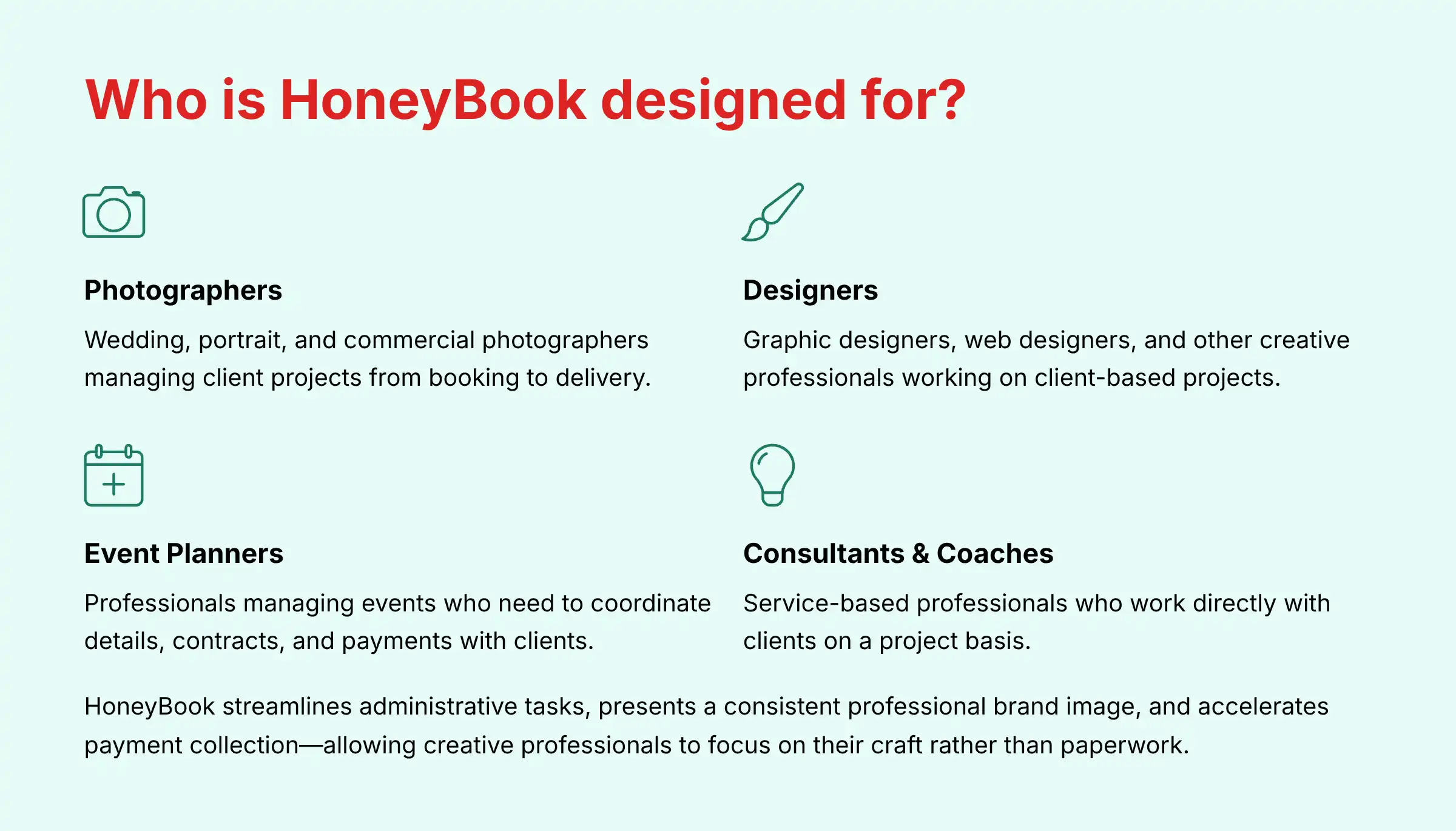

HoneyBook is an all-in-one clientflow management platform specifically designed for solopreneurs, freelancers, and small creative businesses. Its primary users include photographers, wedding planners, graphic designers, consultants, web developers, coaches, and event coordinators who need to streamline their client management processes.
Unlike traditional CRM systems that focus solely on contact management, HoneyBook manages the entire client lifecycle from initial inquiry to final payment and follow-up. It combines essential business tools—invoicing, contract management, proposal creation, scheduling, and payment processing—into a unified, intelligent dashboard.
The platform’s core value proposition is threefold:
- Streamlining administrative tasks through automation
- Presenting a consistent professional brand image to clients
- Accelerating payment collection
HoneyBook helps business owners automate repetitive client communications, track project stages visually, and centralize all client interactions in one secure location.
For small business owners struggling with multiple disconnected tools, HoneyBook serves as a central operational hub that replaces the need to juggle separate software for document signing, appointment scheduling, invoice creation, and payment collection. It’s specifically built for businesses of one (or very small teams) who need operational efficiency and professional client experiences without the complexity of enterprise-level systems.
If you’re looking to explore more comprehensive solutions, check out our detailed HoneyBook Overview and Features guide that covers all the platform’s capabilities in depth.
Is HoneyBook a true CRM or something different?
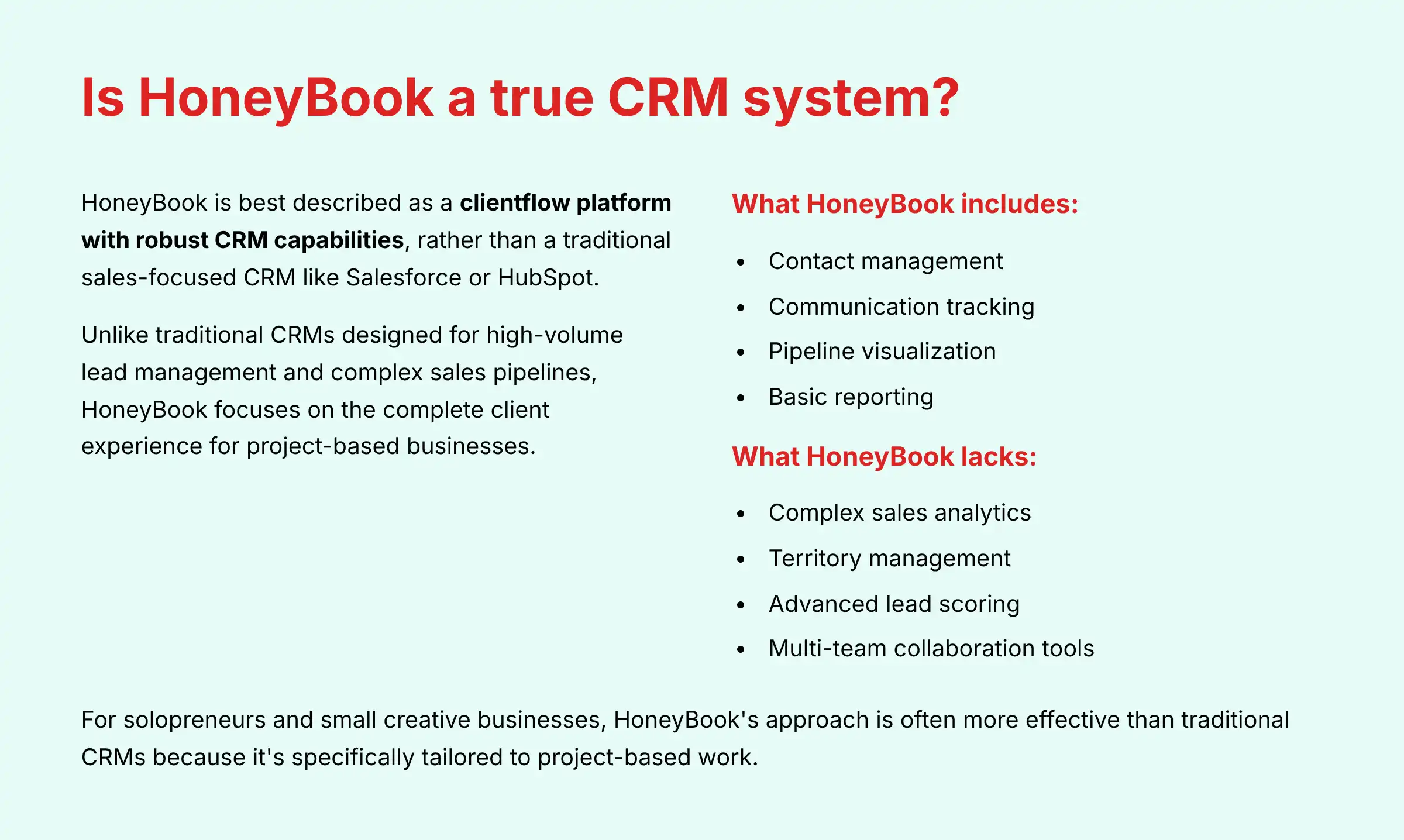

HoneyBook is best described as a clientflow platform with integrated CRM capabilities rather than a traditional sales-focused CRM like Salesforce or HubSpot. This distinction is important for setting appropriate expectations about its functionality.
Traditional CRMs are primarily designed for managing large volumes of leads through complex sales pipelines, often supporting teams of sales representatives with territory management and advanced analytics. HoneyBook takes a fundamentally different approach by focusing on the complete client experience for project-based businesses.
HoneyBook’s CRM functionality centers on:
- Contact organization and communication tracking
- Visual project pipeline management
- Client interaction history
- Basic lead qualification
- Project-based relationship management
However, it doesn’t offer enterprise-level features like:
- Advanced lead scoring algorithms
- Complex sales territory management
- Extensive sales forecasting analytics
- Multi-team permission structures
For solopreneurs and small creative businesses managing client projects, HoneyBook’s approach is often more practical and efficient than traditional CRMs that contain features you’ll never use. The platform’s strength lies in its integration of client management with project execution tools—something traditional CRMs typically lack.
To understand how HoneyBook compares with other solutions, our comprehensive HoneyBook Review provides detailed analysis of its CRM capabilities versus traditional alternatives.
What are HoneyBook’s main AI features and automation capabilities?
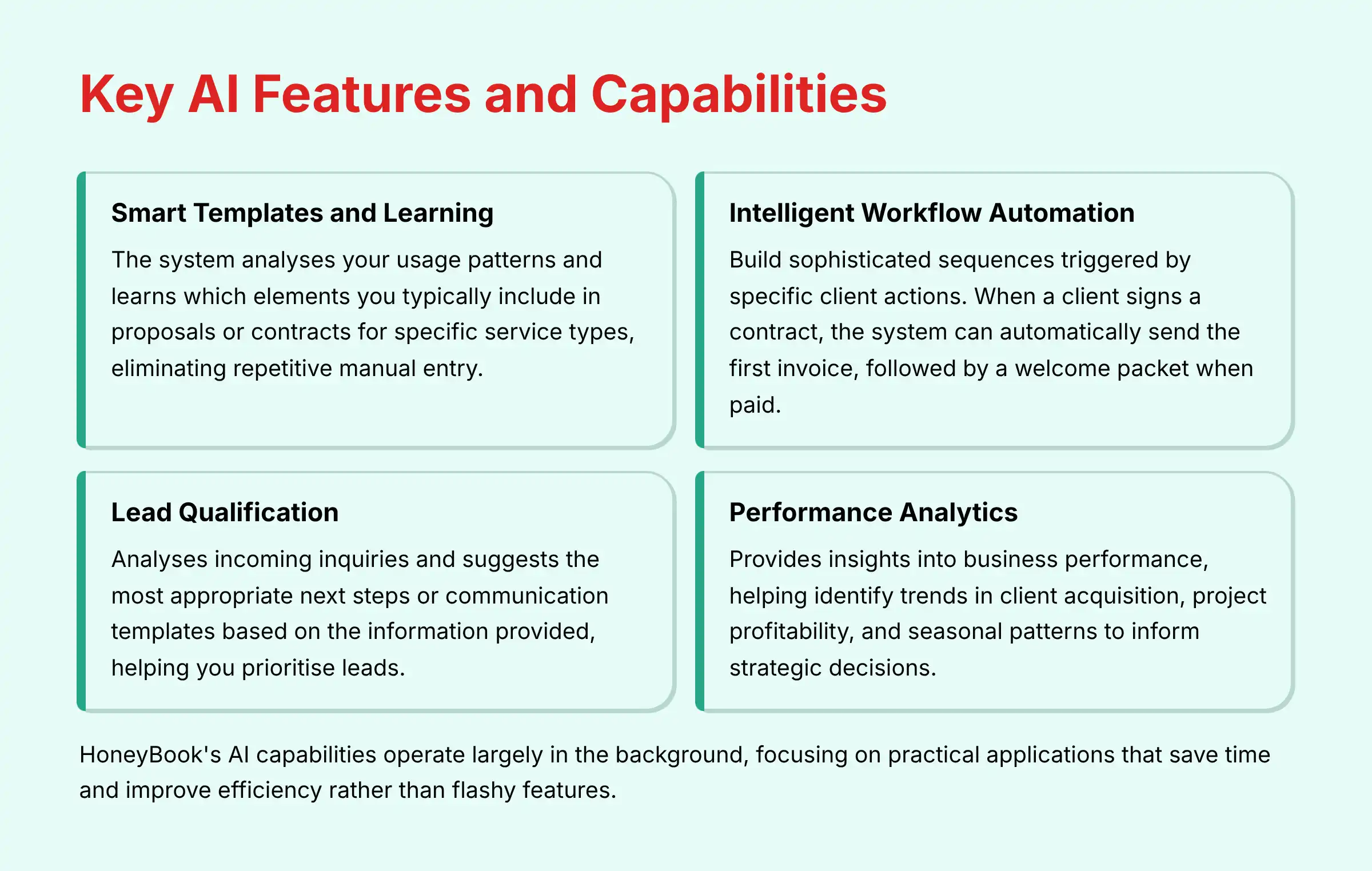

HoneyBook incorporates AI and intelligent automation primarily to accelerate workflows and reduce repetitive tasks for small business owners. While not marketed as a fully AI-powered CRM, the platform leverages intelligent technology in several practical ways that create meaningful time savings.
The key AI-driven and automation features include:
Smart Templates and Learning:
When you create proposals or contracts for specific service types (e.g., “Wedding Photography Package”), HoneyBook’s system learns which components, pricing structures, and contract clauses you typically include. For future clients requesting similar services, it intelligently suggests pre-populating these templates with your standard elements, eliminating repetitive manual setup.
Intelligent Workflow Automation:
You can build sophisticated automation sequences that trigger based on specific client actions or time-based rules. For example:
- When a client signs a contract → automatically send the first invoice with payment instructions
- When that invoice is paid → automatically deliver a welcome packet and scheduling link
- These client-action triggered workflows operate 24/7, advancing projects even when you’re unavailable
Lead Classification and Response Suggestions:
The platform analyzes incoming inquiries and suggests appropriate next steps or communication templates based on the inquiry content, helping you respond faster and more effectively to potential clients. This feature helps prioritize which leads deserve immediate attention based on the information provided in your contact forms.
Behavioral Analytics:
HoneyBook tracks when clients view your proposals, contracts, and invoices, providing insights into their engagement with your materials. This intelligence helps you time your follow-ups more effectively and identify potential issues before they affect your project timeline.
While HoneyBook doesn’t feature the generative AI capabilities for creating content from scratch that some newer platforms offer, its intelligence is focused on practical, time-saving applications that directly address the administrative burdens small business owners face daily. The system’s automation capabilities continue to expand with regular platform updates.
For step-by-step guidance on implementing these features, explore our detailed HoneyBook Tutorials and Usecase section.
Who is HoneyBook NOT suitable for?
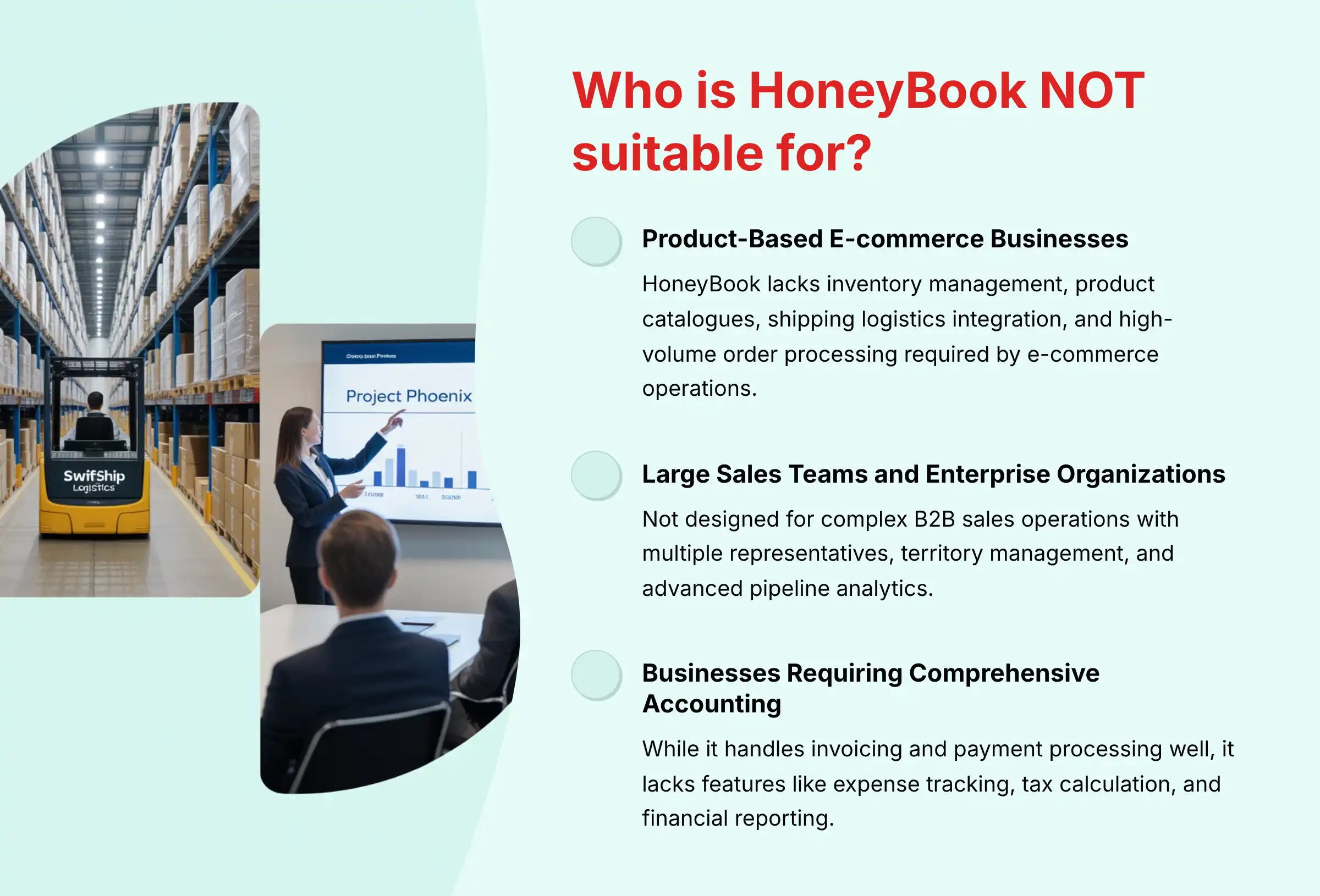

HoneyBook is highly specialized for service-based solopreneurs and small creative businesses, making it unsuitable for several other business types. Understanding these limitations is crucial for making an informed decision about whether the platform aligns with your specific needs.
HoneyBook is likely the wrong choice if:
You run a product-based e-commerce business.
HoneyBook lacks essential e-commerce functionality like:
- Inventory management
- Shipping logistics
- Product catalogs
- Managing thousands of individual product sales
Platforms like Shopify, WooCommerce, or BigCommerce would be more appropriate for product-focused businesses.
You have a dedicated sales team.
As mentioned previously, HoneyBook lacks the advanced sales pipeline analytics, lead routing mechanisms, and granular user permission levels required to effectively manage a B2B sales team across territories or product lines. Traditional CRMs like HubSpot, Pipedrive, or Salesforce would better serve these needs.
You need comprehensive accounting features.
While HoneyBook handles invoicing and payment processing efficiently, it is not a full-fledged accounting solution. It lacks features like:
- Expense tracking
- Tax calculation
- Financial reporting
- Balance sheet management
While it integrates with accounting software like QuickBooks and Xero, it doesn’t replace them.
You require complex, multi-stage project management.
For intricate projects with numerous dependencies, subtasks, resource allocation needs, and Gantt chart visualization, dedicated project management tools like Asana, Trello, ClickUp, or Monday.com would be more suitable. HoneyBook’s project management is primarily linear and client-centric.
You need enterprise-level reporting and analytics.
HoneyBook’s reporting capabilities focus on basic business metrics rather than the advanced, customizable analytics dashboards that larger organizations require for data-driven decision making.
You manage multiple large teams across departments.
HoneyBook’s permission structure and team management features are designed for small teams rather than complex organizational hierarchies with different access requirements.
For businesses that primarily offer services on a project basis and operate with small teams, HoneyBook’s specialized approach offers significant advantages over more general-purpose business tools.
If HoneyBook doesn’t fit your needs, consider exploring our guide to HoneyBook Best Alternatives for comprehensive comparison of similar platforms.
How much does HoneyBook cost and what are the complete fee structures?
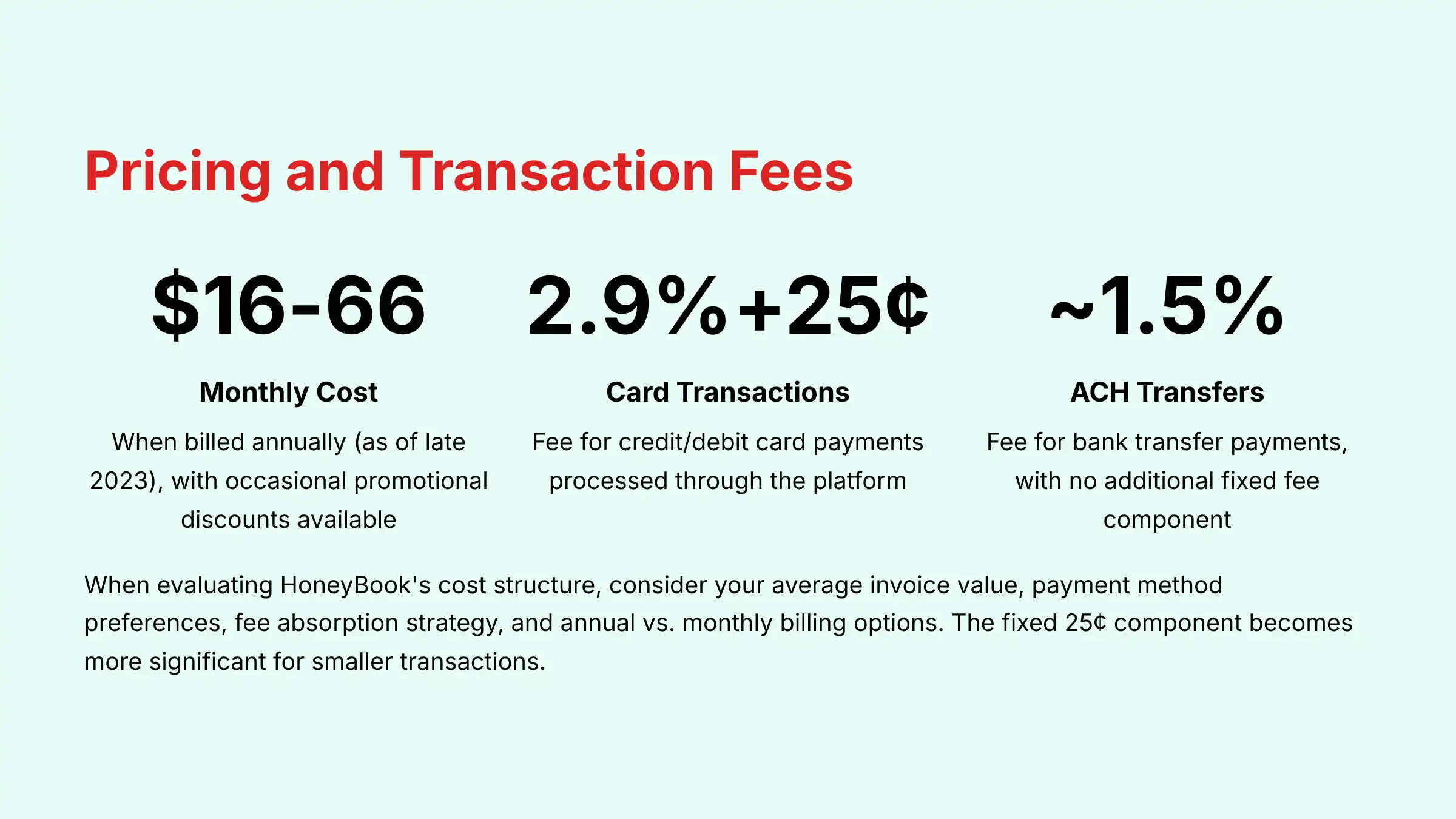

HoneyBook operates on a subscription-based pricing model with several tiers, each offering increasing levels of functionality. As of late 2023, pricing generally ranges from approximately $16 to $66 per month when billed annually, with exact pricing subject to change and occasional promotional discounts available.
Beyond the subscription fee, there is a critical cost component that all users must understand: payment processing fees. These fees apply to all transactions processed through the HoneyBook platform:
Payment Processing Fee Structure:
- Credit/Debit Card Transactions: 2.9% + 25¢ per transaction
- ACH (Bank Transfer) Transactions: ~1.5% per transaction
These processing fees are standard across the industry (comparable to Stripe, PayPal, and other payment processors) and represent the cost of securely handling online payments. The key distinction is that HoneyBook operates its own proprietary payment processing system rather than simply passing transactions through third-party processors.
Important considerations for accurate financial planning:
1. Per-transaction fixed fee impact:
The 25¢ fixed component of the credit card fee structure becomes proportionally more significant for smaller transactions. For example, on a $50 invoice, the fixed fee represents an additional 0.5% of the total.
2. Annual vs. monthly billing:
While annual billing offers significant discounts (often 20-30%), it requires a larger upfront investment. Monthly billing provides more flexibility but at a higher overall cost.
3. Plan limitations:
Each pricing tier has specific limitations on the number of projects, contacts, or team members. Exceeding these limits may require upgrading to a higher tier.
4. No hidden setup fees:
Unlike some competitors, HoneyBook doesn’t charge additional setup or onboarding fees, though premium onboarding services may be available at additional cost.
For accurate financial planning, small business owners should calculate their total cost of ownership by combining the subscription fee with estimated payment processing costs based on their typical transaction volume and average invoice amount. Always check the official HoneyBook pricing page for the most current rates and feature breakdowns for each subscription tier.
HoneyBook vs. Dubsado: Which platform better serves small businesses?
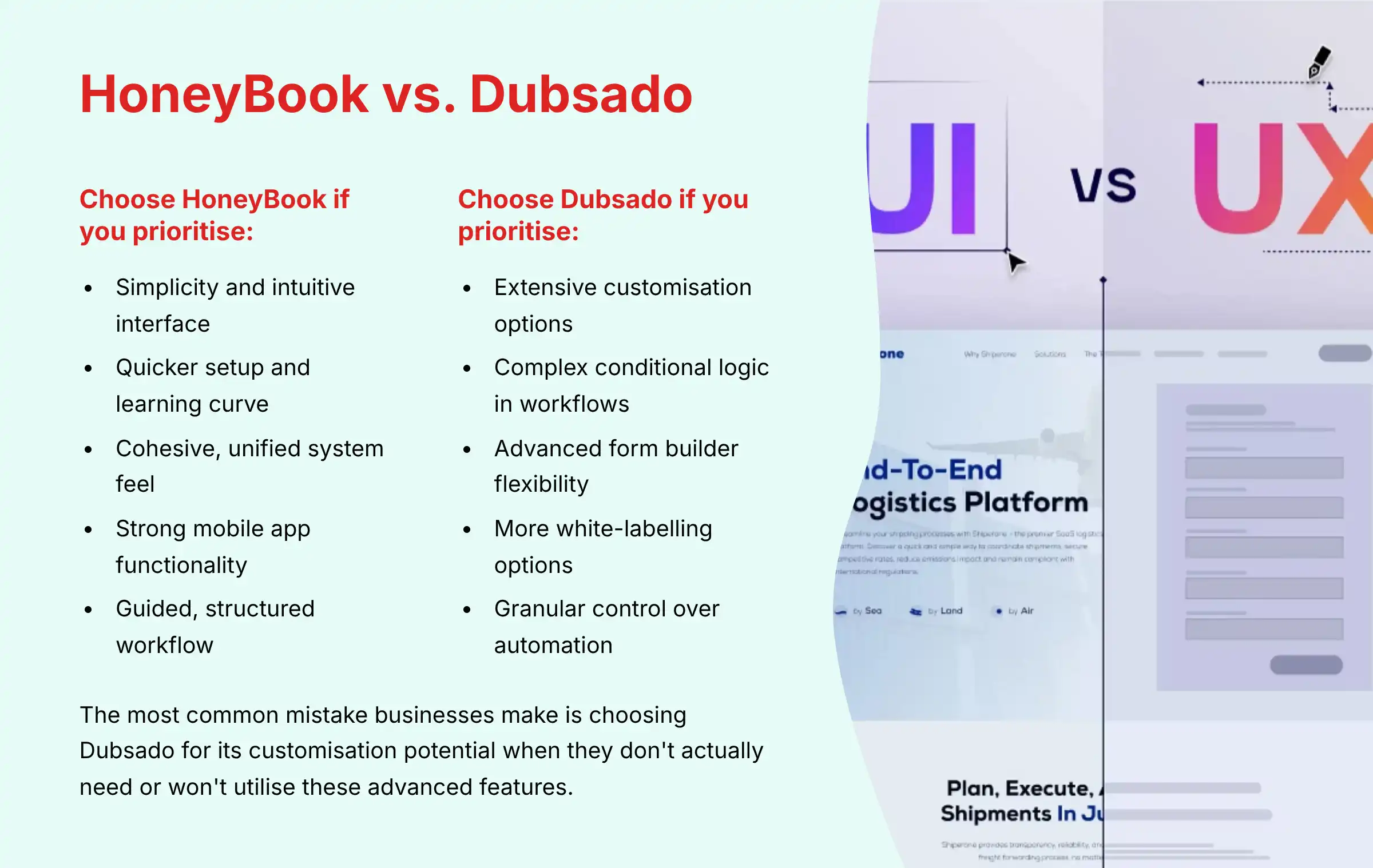

This comparison is particularly relevant as both platforms target similar audiences of creative solopreneurs. The best choice depends entirely on your specific priorities and working style, particularly regarding simplicity versus customization.
Choose HoneyBook if your top priority is simplicity and an integrated experience:
HoneyBook offers a significantly cleaner user interface and gentler learning curve, making it ideal for business owners who want to implement a client management system quickly without extensive setup. Its mobile app is widely considered superior to Dubsado’s, providing better on-the-go functionality for busy entrepreneurs. The entire platform feels cohesive and purposefully designed to minimize friction in the setup process.
Key HoneyBook advantages:
- Faster implementation timeline (typically days vs. weeks)
- More intuitive interface requiring less technical skill
- Superior mobile experience for managing clients on the go
- More streamlined, visually consistent client experience
- Stronger focus on guided setup and template galleries
Choose Dubsado if your top priority is power and extensive customization:
Dubsado provides significantly more powerful and granular workflow automation capabilities. You can build extremely complex conditional logic into your workflows (e.g., “If client selects Package A and answers X on this form, then send Y email, but if they select Package B, send Z email instead”). Its form builder offers more field types and customization options, and it provides more extensive white-labeling capabilities.
Key Dubsado advantages:
- More powerful conditional logic in workflows
- Greater form customization options
- More extensive white-labeling and branding control
- More flexibility in process design
- Potentially lower cost for certain use cases
The Fundamental Tradeoff
The fundamental tradeoff is between ease-of-use and customization depth. HoneyBook is the “Apple” of clientflow platforms—sleek, intuitive, with careful constraints that ensure quality but limit some customization. Dubsado is more like the “Android” of clientflow platforms—more technical to set up but offering greater flexibility for those willing to invest the time in configuration.
For most small business owners who value their time and want a system they can implement quickly, HoneyBook’s approach often provides better real-world results despite having fewer theoretical customization options. The best approach is to trial both platforms with a sample project that reflects your typical workflow to see which feels more natural for your specific business needs.
For a detailed side-by-side analysis, check out our comprehensive HoneyBook Best Alternatives Comparison that covers Dubsado and other leading platforms.
What are the biggest limitations and drawbacks of HoneyBook?
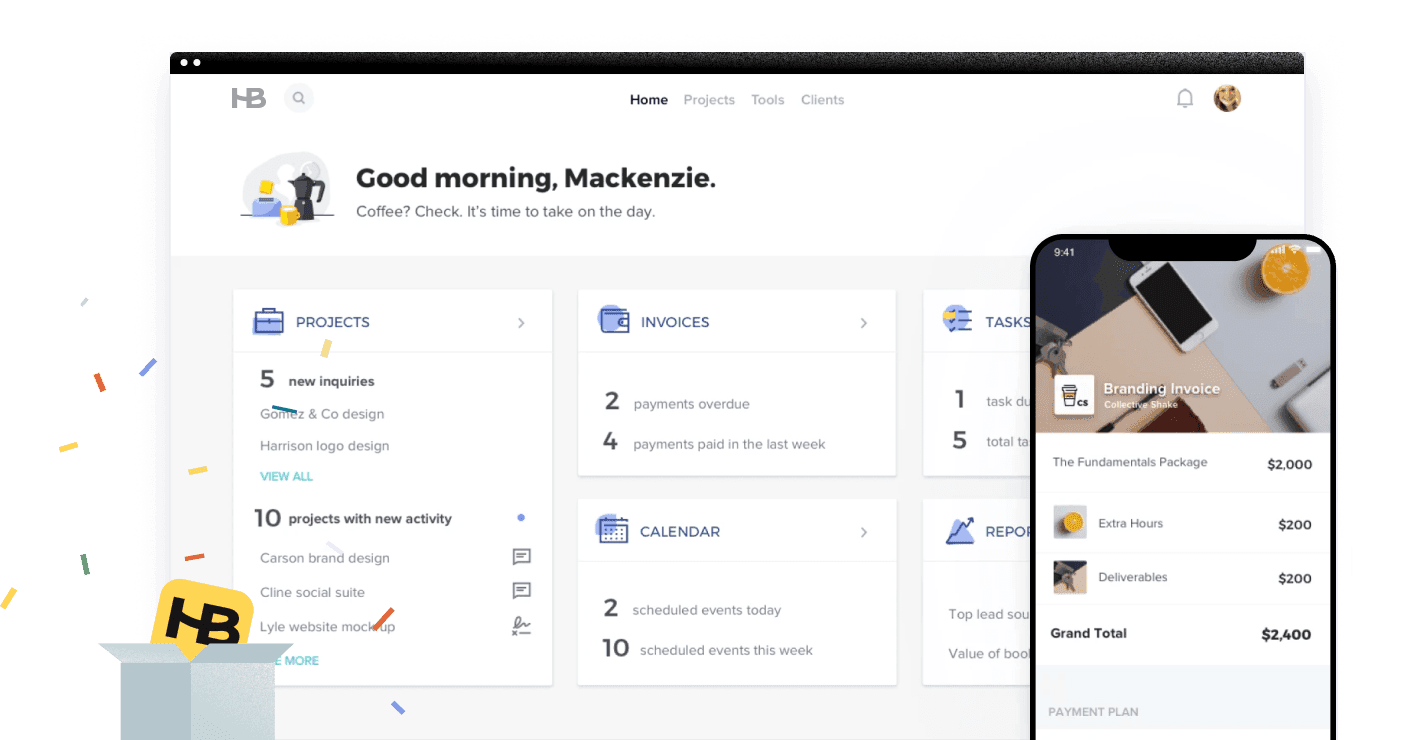

While HoneyBook excels for its target market of service-based small businesses, understanding its limitations is essential for making an informed decision. These constraints may impact your experience depending on your specific business requirements:
1. Limited Customization Depth
Compared to competitors like Dubsado, HoneyBook offers less extensive customization options. While you can add your logo, colors, and basic branding elements, you cannot completely transform the look and feel of client-facing documents and portals. The workflow automation rules are also less complex, lacking the sophisticated conditional logic that power users might require.
2. Payment Processing Lock-in
HoneyBook requires you to use their proprietary payment processing system, which means you cannot integrate with your preferred payment processor (like Stripe or Square) if you have negotiated better rates elsewhere. This limitation can result in higher processing costs for high-volume businesses.
3. Limited Reporting and Analytics
The platform’s reporting capabilities are basic compared to dedicated CRM or business intelligence tools. You can track essential metrics like revenue, project status, and client interactions, but advanced analytics, custom reports, and data visualization options are limited.
4. Team Collaboration Constraints
While HoneyBook supports small teams, it lacks sophisticated user permission levels and collaborative features that larger agencies might need. Team members cannot have granular access controls, and project collaboration features are more basic than dedicated project management tools.
5. Integration Limitations
While HoneyBook integrates with popular tools like QuickBooks, Gmail, and Calendly, its integration ecosystem is smaller than platforms like HubSpot or Salesforce. Custom integrations require technical expertise, and some essential business tools may not have native connections.
6. Storage and File Management
File storage capabilities are limited compared to dedicated cloud storage solutions. For businesses that need to store large volumes of client files, photos, or documents, the storage limits may require upgrading to higher-tier plans or using external storage solutions.
Despite these limitations, HoneyBook’s focused approach and user-friendly design often outweigh these drawbacks for its target audience of creative solopreneurs and small service-based businesses.
For common questions and solutions to these limitations, visit our comprehensive HoneyBook FAQs section.
HoneyBook’s security and data protection measures
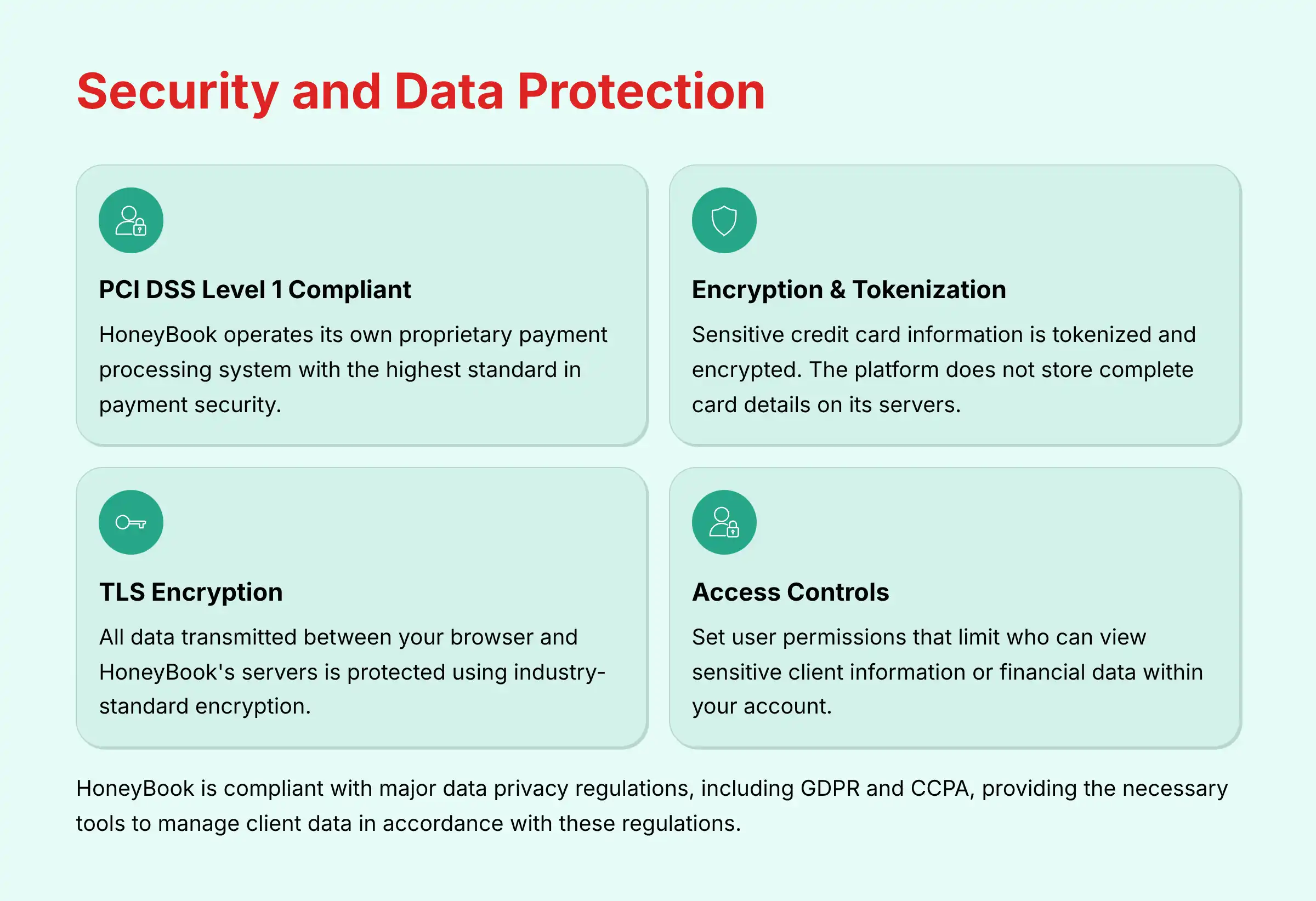

For creative professionals handling sensitive client information, contracts, and financial data, security is paramount. HoneyBook implements enterprise-grade security measures to protect both business owner and client data throughout the platform.
Core Security Features:
Data Encryption
- All data transmission uses 256-bit SSL encryption
- Data at rest is encrypted using industry-standard protocols
- Payment processing meets PCI DSS compliance standards
- Client portal access is secured with HTTPS protocols
Infrastructure Security
- Cloud hosting on secure, monitored servers
- Regular security audits and penetration testing
- 24/7 system monitoring for suspicious activity
- Automated backups with disaster recovery protocols
Access Controls
- Two-factor authentication (2FA) available for account access
- Role-based permissions for team members
- Session timeout controls for inactive users
- IP address restrictions for enhanced account security
Compliance Standards
- GDPR compliance for European client data
- CCPA compliance for California residents
- SOC 2 Type II certified for data handling
- Regular compliance audits and certifications
HoneyBook also provides detailed privacy controls, allowing business owners to manage client data retention, deletion requests, and data portability in compliance with international privacy regulations. The platform’s security documentation is regularly updated and available for review by potential users who require detailed security assessments.
Return on investment analysis for solopreneurs
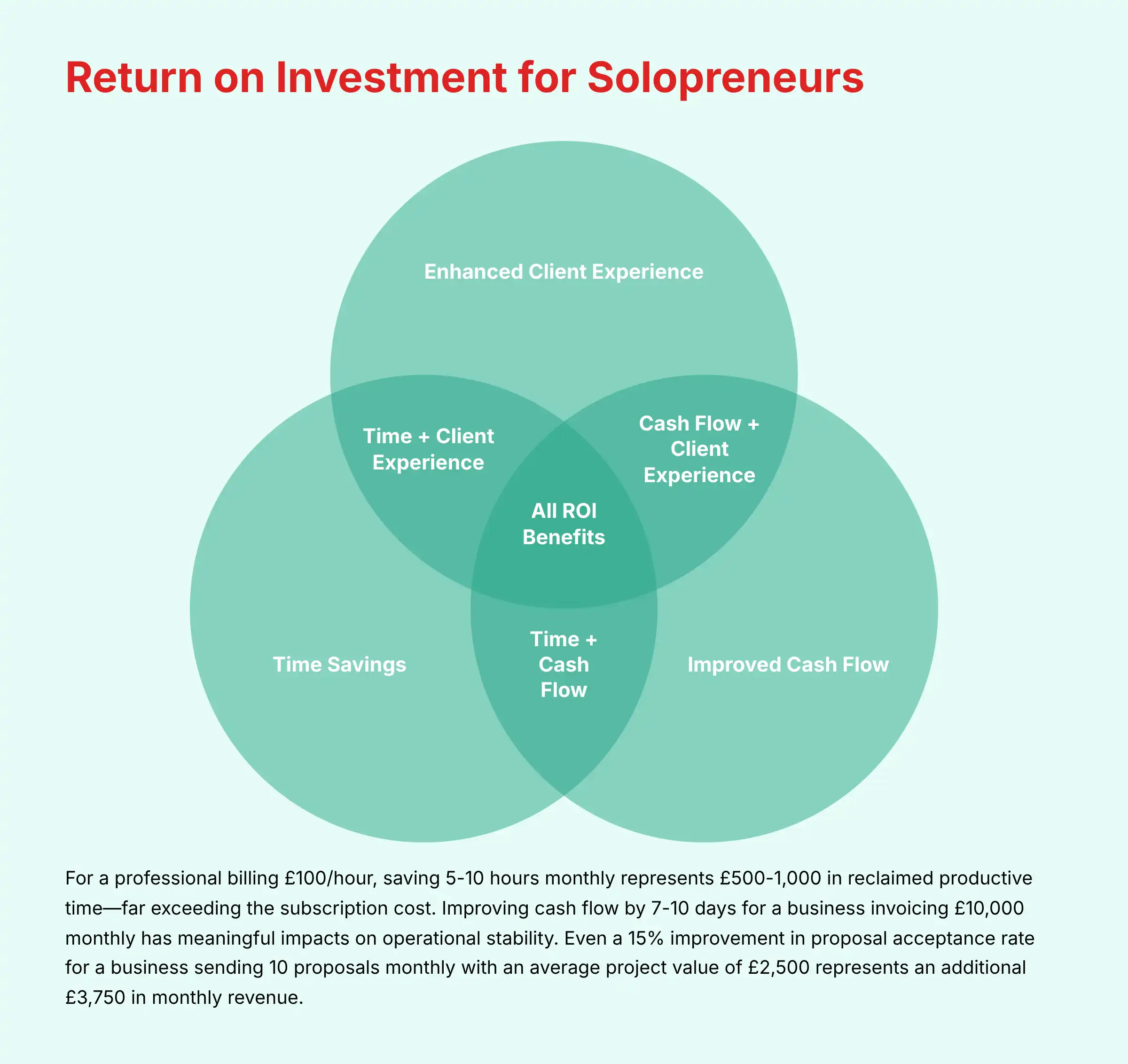

Understanding the true ROI of HoneyBook requires looking beyond the subscription cost to measure the time savings, revenue acceleration, and professional image improvements it provides to solopreneurs and small creative businesses.
Quantifiable Time Savings:
Administrative Task Automation
- Contract Creation: Reduces contract creation time from 2-3 hours to 15-30 minutes using templates
- Invoice Generation: Automated invoicing saves approximately 1-2 hours per client project
- Follow-up Communications: Automated email sequences eliminate 3-5 hours of manual follow-up per month
- Payment Tracking: Centralized payment status saves 2-4 hours monthly in bookkeeping
Revenue Acceleration Benefits
- Faster Payment Collection: Online payment processing typically reduces payment time from 30-45 days to 7-14 days
- Professional Presentation: Branded proposals and contracts can increase close rates by 15-25%
- Reduced Administrative Overhead: Time savings can be reinvested in billable client work or business development
- Client Retention: Professional client experience often leads to higher referral rates and repeat business
Cost-Benefit Analysis Example:
For a freelance photographer billing $100/hour:
- Monthly HoneyBook cost: ~$40 (mid-tier plan)
- Time saved per month: 8-12 hours in administrative tasks
- Billable time recovery value: $800-1,200 per month
- Net monthly benefit: $760-1,160
- Annual ROI: 1,900-2,900% return on investment
Intangible Benefits:
- Reduced Stress: Streamlined workflows reduce administrative burden and mental overhead
- Professional Brand Image: Consistent, branded client experience enhances business credibility
- Scalability Foundation: Systems in place support business growth without proportional administrative increase
- Work-Life Balance: Automation allows for more predictable schedules and reduced after-hours work
The ROI calculation becomes even more favorable when considering that many solopreneurs previously used multiple separate tools (scheduling software, contract platforms, payment processors, invoicing systems) that HoneyBook consolidates into a single solution.
For comprehensive guidance on maximizing your HoneyBook investment, explore our practical HoneyBook Tutorials and Usecase examples.
Getting started with HoneyBook: Trial and setup process
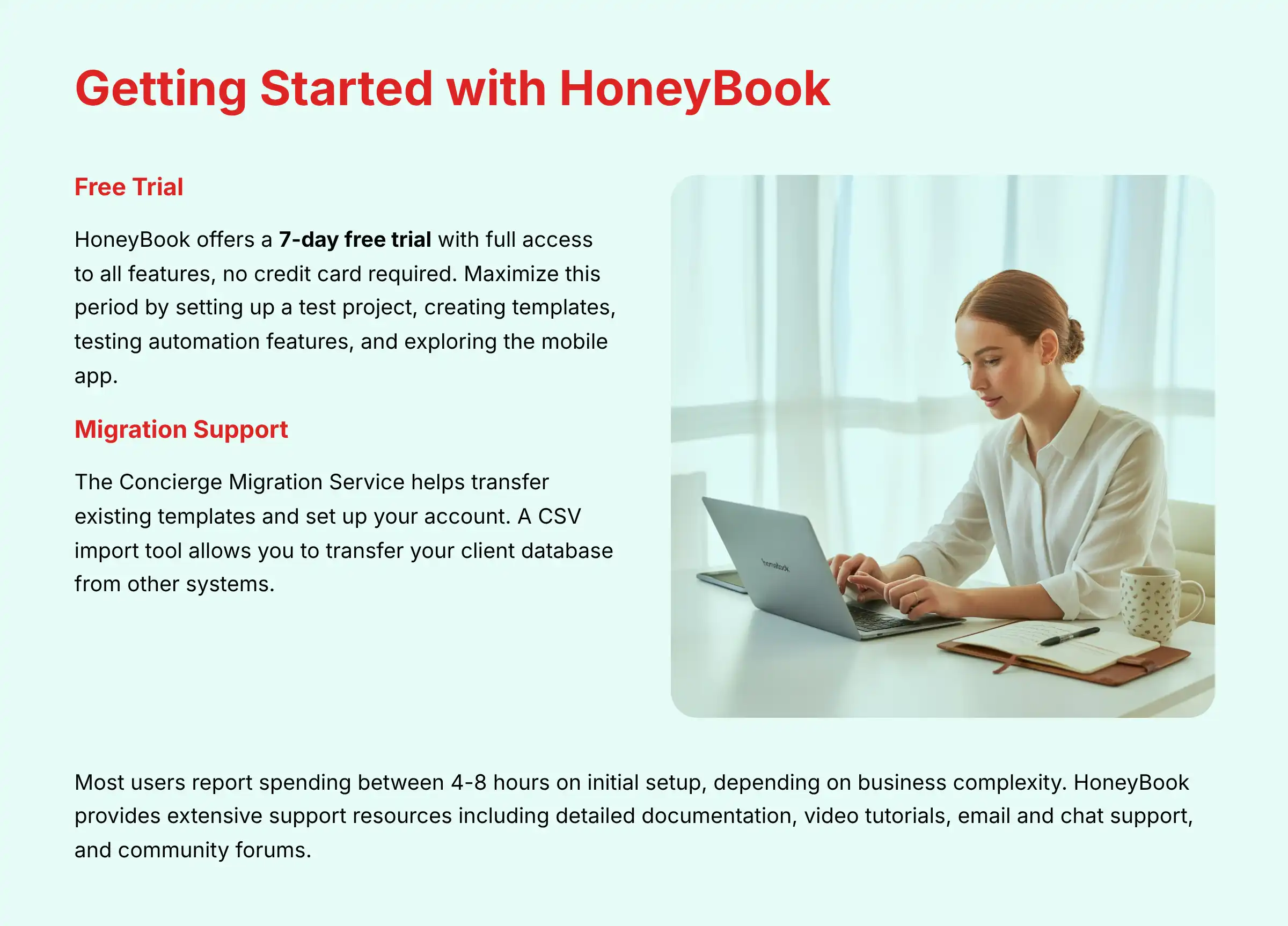

HoneyBook offers a structured onboarding process designed to help new users implement the platform quickly and effectively. The setup process is intentionally streamlined to minimize the time between signing up and managing your first client project.
Free Trial Details:
- Trial Length: 7-day free trial (no credit card required initially)
- Full Access: Complete access to all features during trial period
- Support Included: Live chat and email support available during trial
- No Setup Fees: No additional costs for account activation or initial configuration
Step-by-Step Setup Process:
1. Account Creation and Business Profile (15-20 minutes)
- Business information and contact details
- Service type selection (photography, design, consulting, etc.)
- Basic branding setup (logo, colors, business name)
- Initial template selection based on your industry
2. Essential Templates Configuration (30-45 minutes)
- Proposal template customization with your services and pricing
- Contract template setup with your terms and conditions
- Invoice template configuration with payment terms
- Email template personalization for client communications
3. Payment Processing Setup (10-15 minutes)
- Bank account connection for payment deposits
- Tax information configuration
- Payment method preferences (credit cards, ACH transfers)
- Fee structure review and acceptance
4. Workflow Automation Configuration (20-30 minutes)
- Basic automation rules setup (contract signing triggers, payment confirmations)
- Email sequence configuration for client onboarding
- Project pipeline customization for your typical workflow
- Calendar integration for scheduling and availability
Onboarding Support Options:
Self-Service Resources
- Interactive setup wizard with step-by-step guidance
- Video tutorial library covering all major features
- Template gallery with industry-specific examples
- Knowledge base with detailed documentation
Guided Support
- Live chat support during business hours
- Email support with typical 24-hour response time
- Weekly group training webinars for new users
- Optional premium onboarding sessions (additional fee)
First Project Implementation:
Most users can complete their first client project workflow within 2-3 hours of initial setup. The platform provides sample client data to test workflows before using with real clients, ensuring everything functions correctly before going live.
HoneyBook’s onboarding success rate is notably high, with most small business owners successfully implementing the platform within their first week of use, compared to more complex CRM systems that often require weeks or months of configuration.
Final Recommendations
HoneyBook represents an excellent solution for solopreneurs and small creative businesses who prioritize simplicity, professional client experience, and operational efficiency over complex customization options. The platform excels at streamlining administrative tasks while maintaining a professional brand image throughout the client journey.
The decision to implement HoneyBook should be based on your specific business model, technical comfort level, and growth objectives. For service-based businesses managing client projects with straightforward workflows, HoneyBook often provides the optimal balance of functionality, ease of use, and return on investment.
Before making a final decision, take advantage of the free trial to test the platform with your actual business processes. This hands-on experience will provide the clearest indication of whether HoneyBook aligns with your operational needs and working style.
For additional resources and comprehensive comparisons with other CRM solutions, explore our guide to the Best 10 CRMs for Small Business & Solopreneurs to ensure you’re making the most informed decision for your business.
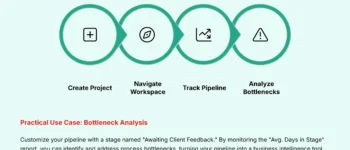

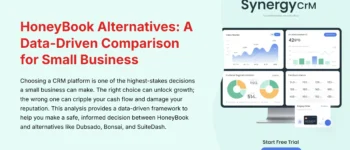


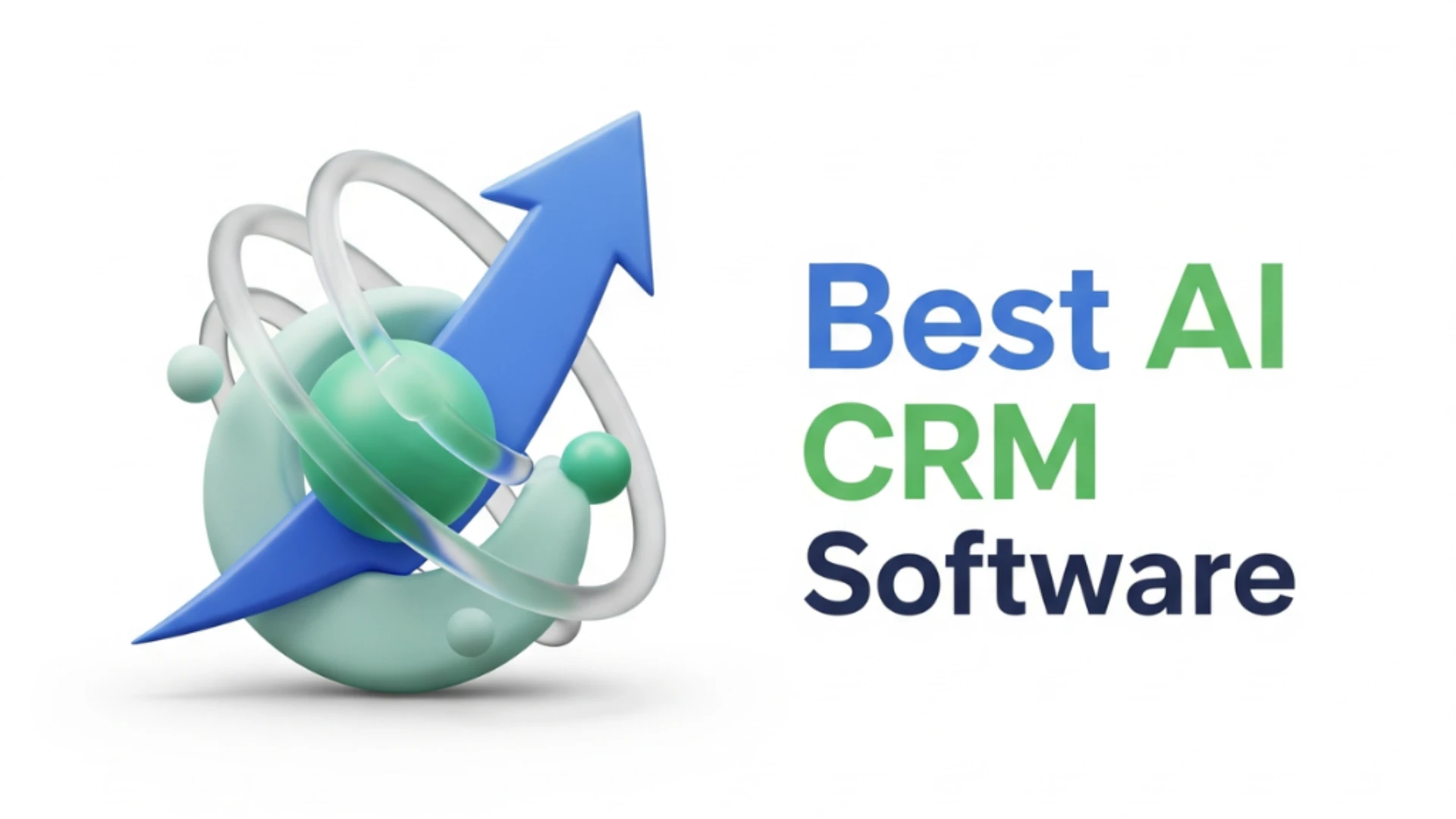
Leave a Reply